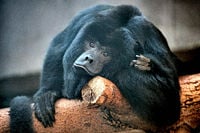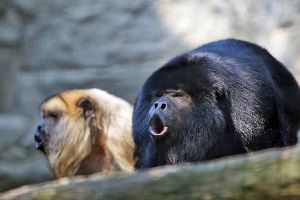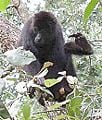Difference between revisions of "Howler monkey" - New World Encyclopedia
Rick Swarts (talk | contribs) |
Rick Swarts (talk | contribs) |
||
| Line 29: | Line 29: | ||
}} | }} | ||
| − | + | '''Howler monkey''' is the common name for the tropical, arboreal [[New World monkey]]s comprising the [[genus]] '''''Alouatta''''' of the [[primate]] family [[Atelidae]], characterized by prehensile tails, completely black faces, and relatively large size. They are well-known for their loud roars, which can be heard by humans even two kilometers (0.6 miles) away (Streier 2004). ''Aloutata'' is the only genus in the subfamily '''Alouattinae'''. Other members of Atelidae, but in another subfamily, are the spider monkeys, woolly spider monkeys, and woolly monkeys. | |
| − | |||
| − | |||
| − | |||
| − | |||
==Overview== | ==Overview== | ||
| − | + | Howler monkeys are '''New World monkeys'''. New World monkeys are one of three major informal groups of the biological order '''[[Primate]]s''', the other two groups being (1) [[prosimian]]s and (2) monkeys and [[ape]]s of the Old World. Together, the New World monkeys and the Old World monkeys and apes are considered to be "higher primates," or ''simians'' (infraorder Similformes), while the prosimians (such as [[lemur]]s) are considered to be the "lower primates." The term ''[[monkey]]'' thus refers to any simian that is not an ape or any primate that is neither an ape or a prosimian. In reality, monkeys are not a single coherent group and therefore do not have any particular traits that they all share.The New World monkeys are found in [[Mexico]], [[Central America]], and [[South America]], and the Old World monkeys are located in [[Africa]], central to southern [[Asia]], [[Japan]], and [[India]]. | |
There are four families of New World monkeys: Cebidae, Aotidae, Pitheciidae, and Atelidae (Groves 2001). The four families are ranked together as the '''Platyrrhini''' clade. All New World monkeys differ slightly from Old World monkeys in many aspects, but the most prominent of which is the [[nose]]. This is the feature used most commonly to distinguish between the two groups. The scientific name for New World monkey, Platyrrhini, means "flat nosed," therefore the noses are flatter, with side facing nostrils, compared to the narrow noses of the Old World monkey. | There are four families of New World monkeys: Cebidae, Aotidae, Pitheciidae, and Atelidae (Groves 2001). The four families are ranked together as the '''Platyrrhini''' clade. All New World monkeys differ slightly from Old World monkeys in many aspects, but the most prominent of which is the [[nose]]. This is the feature used most commonly to distinguish between the two groups. The scientific name for New World monkey, Platyrrhini, means "flat nosed," therefore the noses are flatter, with side facing nostrils, compared to the narrow noses of the Old World monkey. | ||
| − | Most New World monkeys have long, often prehensile tails. Many are small, arboreal (live in [[tree]]s), and [[nocturnal]] (active at night). Unlike most Old World monkeys, many New World monkeys form [[monogamy|monogamous]] pairs | + | Most New World monkeys have long, often prehensile tails. Many are small, arboreal (live in [[tree]]s), and [[nocturnal]] (active at night). Unlike most Old World monkeys, many New World monkeys form [[monogamy|monogamous]] pairs and show substantial paternal care of young. |
| − | + | Howler monkeys (genus ''Alouatta'') belong to the '''Atelidae''' family with the spider monkeys (genus ''Ateles''), woolly monkeys (''Lagothrix''), yellow-tailed woolly monkeys (''Oreonax''), and the woolly spider monkeys (''Brachyteles''). Howler monkeys are placed alone in the '''Alouattinae''' subfamily, while the other members of the family belong to the ''Atelinae'' subfamily. | |
==Description== | ==Description== | ||
Revision as of 19:25, 9 June 2008
| Howler monkeys[1] | ||||||||||||||
|---|---|---|---|---|---|---|---|---|---|---|---|---|---|---|
 Black Howler Alouatta caraya
| ||||||||||||||
| Scientific classification | ||||||||||||||
| ||||||||||||||
| Simia belzebul Linnaeus, 1766 | ||||||||||||||
|
Alouatta coibensis |
Howler monkey is the common name for the tropical, arboreal New World monkeys comprising the genus Alouatta of the primate family Atelidae, characterized by prehensile tails, completely black faces, and relatively large size. They are well-known for their loud roars, which can be heard by humans even two kilometers (0.6 miles) away (Streier 2004). Aloutata is the only genus in the subfamily Alouattinae. Other members of Atelidae, but in another subfamily, are the spider monkeys, woolly spider monkeys, and woolly monkeys.
Overview
Howler monkeys are New World monkeys. New World monkeys are one of three major informal groups of the biological order Primates, the other two groups being (1) prosimians and (2) monkeys and apes of the Old World. Together, the New World monkeys and the Old World monkeys and apes are considered to be "higher primates," or simians (infraorder Similformes), while the prosimians (such as lemurs) are considered to be the "lower primates." The term monkey thus refers to any simian that is not an ape or any primate that is neither an ape or a prosimian. In reality, monkeys are not a single coherent group and therefore do not have any particular traits that they all share.The New World monkeys are found in Mexico, Central America, and South America, and the Old World monkeys are located in Africa, central to southern Asia, Japan, and India.
There are four families of New World monkeys: Cebidae, Aotidae, Pitheciidae, and Atelidae (Groves 2001). The four families are ranked together as the Platyrrhini clade. All New World monkeys differ slightly from Old World monkeys in many aspects, but the most prominent of which is the nose. This is the feature used most commonly to distinguish between the two groups. The scientific name for New World monkey, Platyrrhini, means "flat nosed," therefore the noses are flatter, with side facing nostrils, compared to the narrow noses of the Old World monkey.
Most New World monkeys have long, often prehensile tails. Many are small, arboreal (live in trees), and nocturnal (active at night). Unlike most Old World monkeys, many New World monkeys form monogamous pairs and show substantial paternal care of young.
Howler monkeys (genus Alouatta) belong to the Atelidae family with the spider monkeys (genus Ateles), woolly monkeys (Lagothrix), yellow-tailed woolly monkeys (Oreonax), and the woolly spider monkeys (Brachyteles). Howler monkeys are placed alone in the Alouattinae subfamily, while the other members of the family belong to the Atelinae subfamily.
Description
Howler monkeys range in size from 56 to 92cm, excluding their tail which can be equally as long. Like many New World monkeys, they have prehensile tails. They have a lifespan of 15 to 20 years. These monkeys are native to South and Central American forests. They live in groups of usually about 18 individuals. Threats to howler monkeys include being hunted for food and captivity.
As their name suggests, vocal communication forms an important part of their social behavior. Specifically, the name comes from their distinctive loud barking whoop they make, which can be heard over considerable distances. (As correctly pointed out by William Henry Hudson in his novel Green Mansions, "howler" is a misnomer since the male's voice sounds rather like a powerful roar; female vocalisations sound like a pig's grunt). They have an enlarged basihyal or hyoid bone which helps them make their loud sound. They are considered the loudest land animal. According to Guiness Book of World Record it can be heard clearly for 3 miles.[citation needed] Unlike other New World monkeys, both male and female howler monkeys have trichromatic colour vision.[2]
These large, slow moving monkeys are the only folivores of the New World monkeys. Howlers eat mainly top canopy leaves, together with fruit, buds, flowers, and nuts. They need to be careful not to eat too much of certain species of mature leaf in one sitting, as some of the leaves they eat contain toxins that can poison the monkey.[3]
They move quadrapedally and do not brachiate, usually holding on to a branch with at least two hands or one hand and the tail at all times. Their prehensile tails are strong enough to support the monkey's entire body weight, although they seldom do so. The first 2 fingers of each hand are set apart and are opposable to the other three. They very seldom leave the trees. They rest about 80 percent of the time and are considered the least active of all monkeys.
Howler monkeys live in groups where the number of females is greater than the number of males. Groups may have only one male or several males. Unlike most New World monkeys, juveniles of both genders emigrate from their natal groups,[4] so neither adult males nor adults females in a group are typically related. Fighting among group members is infrequent and generally of short duration. However, serious injuries can result. Both males and females may fight with each other.[4][5] Group size varies by species and by location, with an approximate male to female ratio of a male to four females.[4]
Howlers and humans
While seldom aggressive, howler monkeys do not take well to captivity and are of surly disposition, and hence are the only monkey in their forests not made a pet by the Native Americans [citation needed]. However, the Black Howler (Alouatta caraya) is a relatively common pet monkey in contemporary Argentina due to its gentle nature, in comparison to the capuchin monkey's aggressive tendencies, in spite of its lesser intelligence as well as the liabilities meant by the size of its droppings and the males' loud vocalisation.
Alexander von Humboldt said about howler monkeys that "their eyes, voice, and gait are indicative of melancholy", while John Lloyd Stephens described those at the Maya ruins of Copán as "grave and solemn as if officiating as the guardians of consecrated ground". To the Mayas of the Classic Period, they were the divine patrons of the artisans, especially scribes and sculptors. Copan in particular is famous for its representations of Howler Monkey Gods. Two howler monkey brothers play a role in the 16th century myth of the Maya Hero Twins included in the Popol Vuh.
Other names
Howlers are called "congos" in Nicaragua and Costa Rica. In Belize they are called "baboons", although they are not related to the primate which usually carries that name.
Classification
- Family Atelidae
- Subfamily Alouattinae
- A. palliata group
- Coiba Island Howler, Alouatta coibensis
- Alouatta coibensis coibensis
- Azuero Howler Monkey, Alouatta coibensis trabeata
- Mantled Howler, Alouatta palliata
- Ecuadorian Mantled Howling Monkey, Alouatta palliata aequatorialis
- Golden-mantled Howling Monkey, Alouatta palliata palliata
- Mexican Howling Monkey, Alouatta palliata mexicana
- Guatemalan Black Howler, Alouatta pigra
- Coiba Island Howler, Alouatta coibensis
- A. seniculus group
- Red-handed Howler, Alouatta belzebul
- Brown Howler, Alouatta guariba
- Northern Brown Howler, Alouatta guariba guariba
- Southern Brown Howler, Alouatta guariba clamitans
- Guyanan Red Howler, Alouatta macconnelli
- Amazon Black Howler, Alouatta nigerrima
- Bolivian Red Howler, Alouatta sara
- Venezuelan Red Howler, Alouatta seniculus
- Colombian Red Howler, Alouatta seniculus seniculus
- Alouatta seniculus arctoidea
- Juara Red Howler, Alouatta seniculus juara
- A. caraya group
- Black Howler, Alouatta caraya
- A. palliata group
- Subfamily Atelinae
- Subfamily Alouattinae
Gallery
- Adultapalliata.jpg
Male Mantled Howler, Costa Rica
- Howler.jpg
Howler, Costa Rica
Notes
- ↑ C. Groves, "Order Primates," "Order Monotremata," (and select other orders). Page(s) 148-152 in D. E. Wilson and D. M. Reeder, eds., Mammal Species of the World, 3rd edition, Johns Hopkins University Press (2005). ISBN 0801882214.
- ↑ Jacobs, G. H. and Neitz, M., Deegan, J. F., & Neitz, J. (1996). Trichromatic colour vision in New World monkeys. Nature (382): 156-158.
- ↑ Glander, Kenneth E. (March 1977). Poison in a monkey's Garden of Eden. Natural history: pp. 146-151.
- ↑ 4.0 4.1 4.2 Sussman, R. (July 2003). Primate Ecology and Social Structure, Vol. 2: New World Monkeys, Revised First Edition. Pearson Prentice Hall, pp. 142-145. ISBN 0536743649.
- ↑ Crockett (1997-10-02). "Family Feuds", in Ciochon, R. L., Nisbett, R. A.: Primate Anthology, The: Essays on Primate Behavior, Ecology and Conservation from Natural History. Prentice Hall, p. 32. ISBN 9780136138457.
ReferencesISBN links support NWE through referral fees
- Streier, K.B. 2004. Howlder monkeys and spider monkeys. Pages 155-170 in B. Grzimek, S. F. Craig, D. A. Thoney, N. Schlager, and M. Hutchins. Grzimek's Animal Life Encyclopedia, Volume 14 (Mammals III). Detroit, MI: Thomson/Gale. ISBN 0787657891.
External links
- Primate Info Net Alouatta Factsheets
- Howler monkey audio recording
- Information about howler monkeys from Belize Zoo (photos, video and audio included)
- "The Loudest Animal in the New World," Smithsonian National Zoological Park
Credits
New World Encyclopedia writers and editors rewrote and completed the Wikipedia article in accordance with New World Encyclopedia standards. This article abides by terms of the Creative Commons CC-by-sa 3.0 License (CC-by-sa), which may be used and disseminated with proper attribution. Credit is due under the terms of this license that can reference both the New World Encyclopedia contributors and the selfless volunteer contributors of the Wikimedia Foundation. To cite this article click here for a list of acceptable citing formats.The history of earlier contributions by wikipedians is accessible to researchers here:
The history of this article since it was imported to New World Encyclopedia:
Note: Some restrictions may apply to use of individual images which are separately licensed.


